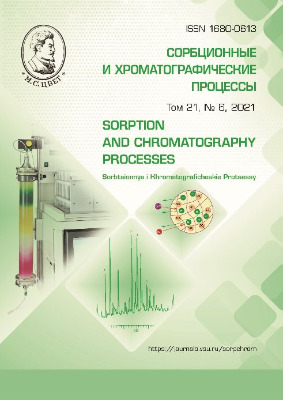Dysprosium-doped mesoporous titanium dioxide as an effective adsorbent for some organic pollutants
Abstract
Study of the adsorption properties of titanium dioxide (TiO2) is an important task, since it has a number of advantages over other adsorbents, such as wide availability, low cost, and low toxicity. The aim of this study was the investigation of the effect of the dysprosium dopant on the adsorption properties of mesoporous titanium dioxide.
Three titanium dioxide samples, doped with different amounts of dysprosium – 2.2, 9.5, and 17.9 wt% – Dy(2.2)/TiO2 Dy(9.5)/TiO2 и Dy(17.9)/TiO2 were obtained. The presence of dysprosium in the structure of TiO2 was confirmed by energy dispersive X-ray spectroscopy (EDX). The textural characteristics of the obtained materials were determined by the low-temperature nitrogen adsorption-desorption method. For the investigation of the structure of the obtained materials, X-ray diffraction analysis (XRD) was used. The adsorption properties of materials were studied based on the adsorption of methyl orange, alizarin red S, benzene and m-, o-xylenes from their aqueous solutions.
The diffraction patterns of the doped samples did not show expressed characteristic reflections for the Dy2O3 phase, which may indicate the statistical location of Dy3+ in interstices or on the surface of TiO2 crystallites. The crystallite size for doped samples decreased compared to the size for undoped TiO2. All isotherms were characterized by the presence of hysteresis loops, which is a characteristic feature of Langmuir type IV isotherms and indicates that all synthesized samples were mesoporous materials. The specific surface area of doped samples increased compared to undoped TiO2. It was shown that doping with dysprosium improved the adsorption characteristics of all the studied samples. The Dy(2.2)/TiO2 sample demonstrated the highest adsorption activity for alizarin red S, benzene, m- and o-xylenes. The concentration of m- and o-xylenes in the solution after 2.5 h decreased by 79.2 and 78%, respectively, benzene by 94%; alizarin red S was completely adsorbed after 1.5 h. Samples of mesoporous titanium dioxide doped with 9.5 and 17.9% dysprosium exhibited the highest adsorption activity towards methyl orange.
Downloads
References
Varjani, S., Joshi, R., Srivastava V.K., Environ. Sci. Pollut. Res., 2020, Vol. 27, pp. 27172-27180. DOI: https://10.1007/s11356-019-04725-x
Ani I.J., Akpan U.G., Olutoye M.A., Hameed B.H., Journal of Cleaner Produc-tion, 2018, Vol. 205, pp. 930-954. DOI: https://10.1016/j.jclepro.2018.08.189
Muhammad I., Kalsoom A., Khan M.I., Tahseen K. et al., Current Pharmaceutical Design, 2019, Vol. 25, pp. 3645-3663. DOI: https://10.2174/1381612825666191021142026
Nidheesh P.V., Minghua Zh., Mehmet A.O., Chemosphere, 2018, Vol. 197, pp. 210-227. DOI: https://10.1016/j.chemosphere.2017.12.195
Dongle Cheng, Huu Hao Ngo, Wenshan Guo, Soon Woong Chang et al., Journal of Hazardous Materials, 2020, Vol. 387, 121682. DOI: https://10.1016/j.jhazmat.2019.121682
Isiuku Beniah Obinnaa and Enyoh Chris-tian Ebere, Analytical Methods in Environmental Chemistry Journal, 2019, Vol. 2, pp. 5-38. DOI: https://10.24200/amecj.v2.i0366
Zahra R., Ali Morad Rashidi, Abbass K., Mohhammad Taghi Samadi et al., Journal of Industrial and Engineering Chemistry, 2018, Vol. 61, pp. 416-426. DOI: https://10.1016/j.jiec.2017.12.041
Asadollah Mohammadi, Payam Veisi, Journal of Environmental Chemical Engineering, 2018, Vol. 6, I. 4, pp. 4634-4643. DOI: https://10.1016/j.jece.2018.07.002
Syieluing Wong, Nurul Atiqah Najlaa Yac'cob, Norzita Ngadi, Onn Hassan et al., Chinese Journal of Chemical Engineering, 2018, Vol. 26, I. 4, pp. 870-878. DOI: https://10.1016/j.cjche.2017.07.015
Riki J. Drout, Lee Robison, Zhijie Chen, Timur Islamoglu, Omar K. Farha, Trends in Chemistry, 2019, Vol. 1, I. 3, pp. 304-317. DOI: https://10.1016/j.trechm.2019.03.010
Varghese A.G., Paul S.A., Latha M.S., Environ. Chem. Lett., 2019, Vol. 17, pp. 867-877. DOI: https://10.1007/s10311-018-00843-z
Mustapha S, Tijani J.O., Ndamitso M.M., Abdulkareem A.S. et al., Environmen-tal Nanotechnology, Monitoring & Man-agement, 2021. Vol. 15, 100414. DOI: https://10.1016/j.enmm.2020.100414
Ahmed Saud Abdulhameed, AbdulKa-rim-Talaq Mohammad, Ali H. Jawad, Journal of Cleaner Production, 2019, Vol. 232, pp. 43-56. DOI: https://10.1016/j.jclepro.2019.05.291
Onkani S.P., Diagboya P.N., Mtunzi F.M., Klink M.J. et al., J. Environ. Manage, 2020, Vol. 260, 110145. DOI: https://10.1016/j.jenvman.2020.110145
Shivaraj B. Patil, Patil S. Basavarajappa, Nagaraju Ganganagappa, Jyothi M.S. et al., International Journal of Hydrogen Energy, 2019, Vol. 44, Is. 26, pp. 13022-13039. DOI: https://10.1016/j.ijhydene.2019.03.164
Alireza Haghighat Mamaghani, Fariborz Haghighat, Chang-Seo Lee, Applied Catalysis B: Environmental, 2020, Vol. 269, 118735. DOI: https://10.1016/j.apcatb.2020.118735
Nobuaki Negishi, Masami Sugasawa, Yukari Miyazaki, Yuki Hirami, Setsuko Koura, Water Research, 2019, Vol. 150, 2019, pp. 40-46. DOI: https://10.1016/j.watres.2018.11.047
Perović K, dela Rosa FM, Kovačić M, Kušić H. et al., Materials, 2020; Vol. 13, 1338. DOI: https://10.3390/mal13061338
Zikriya M., Nadaf Y.F., Vijai Bharathy P., Renuka C.G., J. Rare Earths, 2019, Vol. 37, pp. 24-31. DOI: https://10.1016/j.jre.2018.05.012
Mathew S., Ganguly P., Kumaravel V., Harrison J. et al., Mater. Today: Proc., 2020, Vol. 33, pp. 2458-2464. DOI: https://10.1016/j.matpr.2020.01.336
Stengl V., Bakardjieva S., Murafa N., Materials Chemistry and Physics, 2009, Vol. 114, pp. 217-226. DOI: https://10.1016/j.matchemphys.2008.09.025
Brunauer S., Deming L.S., Deming W.E., Teller E., J. Am. Chem. Soc., 1940, Vol. 62, pp. 1723-1732.
De Bore J.H., in The Structure and properties of Porous Materials ed., D. H. Everett and F. S. Stone, Butterworths, London, 1958, pp. 68-94.







